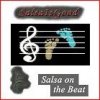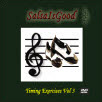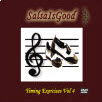| |
From Salsa to Mambo via Cha Cha Cha DVD
Narration |
top |
The purpose of this DVD is for you to learn these 13 footwork elements. 90% of the salsa and mambo you dance socially consists in performing these footwork elements. Salsa and Mambo dancing have an incredibly large repertoire in the armwork, but this variety is built on a small number of footwork elements. Learning these footwork elements properly will give you the foundation to handle 90% of what Salsa and Mambo may ask from you.
It is important that you learn to execute these footwork elements both on1 and on2, because we want to make sure that you can dance with everyone in your salsa club and in every salsa club in the world. Learning to dance fluently on1 and on2 takes a while and at times may be frustrating. We believe this happens because this conversion is usually taught in an unnecessarily complicated way.
Two tools can help make it much simpler: one is ChaChaCha, which is danced on2 and in which ‘catching the 2’ is much easier than in Salsa. The second one is that there are 2 on2 styles: classic and modern mambo. They are interchangeable, in the sense that classic and mambo dancers can dance with one with no problem. You may happen to find one easier than the other. ChaChaCha offers the way to learn both quickly; and then it’s up to you which one you stick to.. so, let’s begin.
On1
Just to make sure we know what we are talking about, we assume you know how to dance this way.... we also assume you understand that when we dance salsa, the basic music count covers 2 bars of music..
To understand the difference between on1 and on2, it important to understand what the 'break' is.. the break is the most forward or the most backward step in the basics... this is the break forward... and this is the break backward. So dancing on1 means breaking on1; also when we dance on1 the first step of the basic steps sequence is a break.
On2
There are 2 ways of dancing on2. Today the most popular is modern mambo, or on2 NY style. You see the basic steps in front of you now. It is called on2 because the break happens on the second beat. However the first step of the sequence is not a break... we step to beats 1,2,3 – 5,6,7 like when we dance on1; the difference is that now the break is on the second beat and the first step is not a break. Don’t worry about trying this out for now.. just keep this in mind for later on.
Currently less popular is classic mambo, or on2 PR style. Here it is danced for you... It is called on2 because here also the break happens on the second beat. However the first step of the sequence is a break... we step to beats 2,3,4 – 6,7,8. This is like dancing on1 but one beat later.. it is our favourite and it is a pity that currently it is less used.. some people do not even know it exists (!!).
In reality, while in standard on2 classes teachers mostly use on2 modern mambo timing, when they dance, many of those very teachers often dance to classic mambo timing because it is so much more natural.. but don’t tell anyone, or we will be in trouble (joke) !!
Cha Cha Cha
There are many reasons why you would want to dance ChaChaCha. The main one is that it is so much fun. Here we stick to a more pragmatic one.. in ChaChaCha it is much easier to dance on2. Indeed, while in salsa some people may debate whether we should dance on1 or on2, in ChaChaCha there is no debate.. it should be on2, it is just so natural that trying dancing on1 feels odd. Let’s see why.
Why does ChaChaCha music has such funny name? Because of the ChaChaCha shuffle sound the feet make when you dance. And why do the feet make such sound? Because that sound matches the music so well
Here is the crucial part.. the ChaChaCha shuffle in the feet matches the ChaChaCha sound in the music only if you dance on2. If you dance on1 feet and music don’t match anymore
So, we have sorted out why we have to dance ChaChaCha on2. If this is not clear.. we suggest you rewind and go through this chapter a few times.
Once this is clear, it is time to exercise. Go to the main menu, choose the section Exercises 1-15 and select Exercise 1. Alternatively, simply click on the ‘Go to Exercise 1’ button you see highlighted now. You will hear a ChaChaCha rhythm in which the ChaChaCha sound is emphasised so you won’t miss it. This clip loops forever, that is, it repeats continuously without stopping so that you never need to rewind. It is designed this way so that you can do each exercise for as long as you need. When you are happy with your progress and you want to change exercise, click on ‘Return to Exercise Menu’ or on ‘Return to Instructions’ to get back to this point of the DVD.
Dance to it over and over until you are completely natural to it.. until you do not have to listen to the ChaChaCha shuffle anymore.. until the music has moved down to your feet to drive your shuffle.
Notice that in real ChaChaCha music this ChaChaCha shuffle sound will not be emphasised so clearly. But once you get used to it you will be able to recognise it immediately in all your favourite real ChaChaChas.
Once you have learnt this, you find yourself breaking on2, that is stepping forward on the second beat, and back on the 6th beat, naturally... without even being aware of it. This is simply the result of matching the feet shuffle to the ChaChaCha sound in the music.
To understand why you find yourself naturally dancing on2 we need to realise that the first ChaChaCha shuffle happens on the beats 4 and 5, as it is shown in the beat counter on the screen, and the second one on beats 8 and 1.
When you dance salsa or mambo, this ChaChaCha sound may not be found in the music so you will need to rely on finding the second beat in the bar of music; what we want to do now, is to train you to find this beat in ChaChaCha, since here this is easier; it is easier both because ChaChaCha music is slower and because we are guided by the shuffle.
Where is this second beat? If you have our Salsa on the beat timing CD or our Salsa on the Spur of the Music DVD you know the answer already. It is in that very high pitch and very loud ‘slap’ on the conga.
In the music you are listening to now, this conga beat is strongly emphasised so you can’t miss it.. it happens on beat 2 and 6. Notice how this sound matches the forward and back steps and pay attention to the beat counter in the screen.
It is now time to exercise again. Click on the ‘Go to Exercise 2’ button you see highlighted now or select Exercise 2 from the Main Menu. Now the music places emphasis both on the shuffle and on the conga high pitch notes on beats 2 and 6. Once again, dance to this over and over, now focussing mostly on the conga slap.
This is now your most important step in the basics.. make it such.. emphasises it.. but not with your body.. we do not want to see this, this is really ugly... rather emphasises it with your timing.. with your rhythm.... generate a little hesitation just before it.. it does not need to be very noticeable, here it is a bit exaggerated on purpose..; it is an hesitation you need to feel for yourself, not necessarily show.. enjoy those 2 and 6 beats.. stay on them just a little longer.. a fraction of a second longer.. ‘milk’ them.. try to dance focussing just on 2 and 6...
Full ChaChaCha rhythm and orchestration
It is now time to incorporate what you learn so far, first in a complete ChaChaCha rhythm in which the emphasis on shuffle and beats 2 and 6 is removed. This will help you to start to recognise these elements in the full ChaChaCha rhythm as in Exercise 3. Do this exercise over and over, until you are able to recognise these elements in a jiffy.. Then, try Exercises 4 and 5; these contain loops of real Chachacha music will full orchestration, so that you get used to what you may dance in a club.
Once you get here, it is time you start to test your learning. Do this with Exercise 6, 7 and 8. In these clips, at a certain point both the tutor and the beat counter disappear; keep on dancing to the music following your internal clock. Once the tutor and the beat counter appear again, check that you are in synch with them. If you consistently find yourself in synch, then you can progress to the next session; if not, keep doing the exercises.
From ChaChaCha to salsa and mambo on2 basic steps
That’s it.. now you know how to dance classic and modern mambo.. problem solved! You don’t believe us?? Of course you do.. look.
You have learnt to dance ChaChaCha on2; when you do that you step on beats 1,2,3,4 and 5,6,7,8 and 1.. all you have to do now is to take some steps out and this is much simpler than adding steps, right?
Let’ start from removing the shuffle.. this is what you see now.. we dance ChaChaCha without the shuffle.. which means we step on the full 8 beats of the 2 bar music phrase. You may want to stop the DVD now and practise with Exercise 9 for a while to get used to this
We are still dancing to ChaChaCha music because this is what we got used to so far.. but soon we will move to salsa or mambo. What you see now is as if we were dancing both classic and modern mambo at the same time.. we can obtain either of them by just removing two more steps. Which ones?
If we remove steps 4 and 8, we get modern mambo.. remember in modern mambo we break on the second beat but we step on 1.. the first step is not a break.
What you see now is modern mambo steps danced to ChaChaCha music; once again, we suggest that you stop the DVD now and practise with Exercise 10 for while to get used to this.
If however we remove steps 1 and 5, we get classic mambo.. remember in classic mambo we break on the second beat and we do not step on 1.. the first step is a break.
What you see now is classic mambo steps danced to ChaChaCha music; as before you may want to stop the DVD now and practise with Exercise 11 for while to get used to this.
Let’s go through this again, because explaining it with words is more complicated than doing it.. and once you understand this, all on2 mysteries disappear.
What you see now is again ChaChaCha with no shuffle. It is almost as if you were dancing salsa or mambo with a tap, which makes you mark all 8 music beats. The important part is that you are breaking on beats 2 and 6.
Now, if we drop steps 4 and 8.. we have modern mambo basic steps.. 1,2,3 5,6,7 breaking on 2. However, if instead we drop steps 1 and 5.. we have classic mambo basic steps.. 2,3,4 6,7,8.. still breaking on 2.
So easy... so very easy.. now make sure that what you understood with your brain goes down to your feet.. exercise... don’t be lazy.. don’t assume you know them already, do them properly and test yourself to make sure you have learnt.
From ChaChaCha to salsa and mambo music
Obviously, we will dance salsa or mambo to salsa music not to ChaChaCha music. So we need to take our music understanding from ChaChaCha to salsa and mambo music and, with it, the basic steps. The key is that famous high pitch loud conga note. It is still there for us to anchor our listening.
This is a piece of salsa music in which this note is strongly emphasised.. much, much louder than it would be in real music. In exercises 12 and 13 you need to focus on this note and perform the break to it; if you dance modern mambo you can use Exercise 12 and if you dance classic mambo you can use Exercise 13.
What happened to the ChaChaCha sound in the salsa music? In most songs, it is simply gone. In its place you hear two low pitch conga notes, as you learnt in our Salsa on the beat timing CD or our Salsa on the Spur of the Music DVD. These mark beats 4 and 8 (‘4 and’ and ‘8 and’ to be more precise) If you dance classic mambo you will step on them; if you dance modern mambo you will pause to them. You can get used to this sound by using Exercises 14 and 15.
What about actually dancing?
If you have followed all exercises, you are half way through the challenge. The next part is to port what you learnt to actual couple dancing. This involves adapting the footwork you perform while executing the usual salsa turn patterns on1 to the new counting on2. There are a few issues about leading, for the guys, but one thing at the time... this is for another DVD. Here we focus on the footwork.
We have two pieces of good news. The first one is that for a good 90% of salsa and mambo you will ever dance, all the footwork you need reduces to a handful of elements. Most of variations in salsa and mambo dancing come from the armwork and positioning of the dancers, not from the footwork; if you don’t believe us, check out our Salsa Dictionary
The second piece of good news is that if you know how to execute these elements on1, all you really need to worry about is to focus on the ‘2’ beat.. we will get to this later, for now let’s worry about the basic footwork elements.
Basic footwork elements
Yes, 90% of your salsa and mambo partner dancing revolves around a handful of footwork elements and this includes both men and ladies’ steps! By the time you worry of the remaining 10%, you will probably have mastered both on1 and on2 and you won’t need to worry about this anymore.
Here is the list of this basic footwork. The couple dancing you see now shows these elements in a sequence. Don’t worry about the armwork, just focus on their feet and you will notice that they are using only the footwork elements above.
How can you learn all this? By doing, of course, how else? For each footwork element mentioned above, we provide a set of exercises; after reviewing each element executed by the couple, we show each footwork element on1, in ChaChaCha and then on2 modern mambo and on2 classic mambo. The on1 version may be useful to clarify the footwork. The ChaChaCha version, as we explained before, helps you to learn how to execute the steps slowly and by breaking on2. Then, again as we explained before, you decide which basic steps to remove from the ChaChaCha version in order to obtain the on2 modern mambo version or the on2 classic mambo version. Remember, when you execute the footwork on2, always focus on the conga high pith slap, the ‘2’ beat, to keep the time properly. All these exercises can be found in the Exercise 16-30 section.
Footwork routine
Finally, we put together all the footwork elements into a routine for solo exercising. This contains all elements, both the ones for ladies and for men, into a single solo sequence. The reason both man and ladies footwork is included is that we believe it is very important that dancers understand the footwork their partner has to execute as well; this will improve your partner dancing too.
When you dance socially you will never need to execute this solo routine, of course, but learning the sequence of individual moves and repeating it many times will make all footwork elements natural and instinctive. Use this routine to master all footwork elements on1, and on2 in both NY and PR style by focussing on the ‘2’ slap of the conga.
The idea is to execute this routine over and over, daily for a few weeks. Once you are in full control of it, in all styles, you will be ready for 90% of what salsa may ask from you, at least for what regards the footwork, and in any style you may need to dance.













